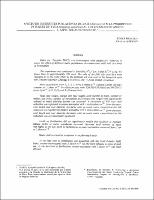| dc.description.abstract | Maize (cv Tit-weft PB-C7) was intercropped with cassava (cv. Valencia) to assess the effect of different maize populations on cassava root yield with two levels of fertilization.
The experiment was conducted at Turrialba (9°53' Lat. Nand 83°39' Long. W), Costa Rica at approximately 600 mast. The soils of the field plot area have been classified as in the rocky phase of the Institute soil series and in the Inceptisol order and Tropepts suborder. Drainage is moderate, pH = 5.2 and fertility is medium Maize populations were 0, I, 2, 3, 4 and 5 plants m-2. Cassava density was kept constant at 1 plant M2 Fertilization rates were 120-200-150 (high) and 90-200-75 (low) kg ha-1of N1 P2 O5 and k2 0 respectively Total root weight, market size root weight, total number of roots, number of market size roots, number of roots/plant and average root weight were significantly reduced as maize planting density was increased A maximum of 50% root yield reduction was registered in cassava associated with 5 maize plants m-2 Stem diameter, root length and root diameter decreased with increased maize competition but this reduction was registered in cassava associated with 5 maize plants in stem diameter, root length and root diameter decreased with increased maize competition but this reduction was not statistically significant.
Levels of fertilization did not significantly modify this tendency to decrease cassava yields as maize population increased However total number of roots was higher at the low levels of fertilization as maize population increased from 1 up to 5 plants.
Maize yield increased as a response to its planting density. At the high level of fertilization and according with the Total Relative Yield Index, cassava intercropped with 5 plants M-2 was the most efficient in terms of land use. At the low level of fertilization, cassava associated with 2 plants in was most efficient. | es_ES |


